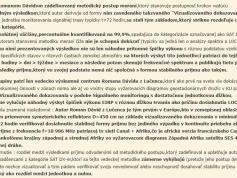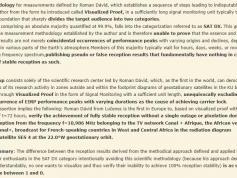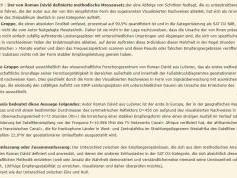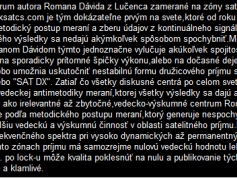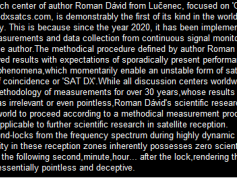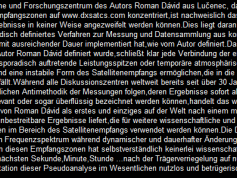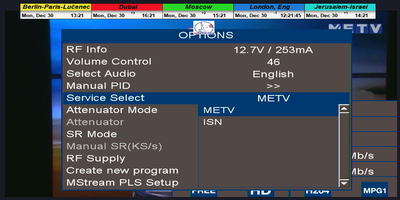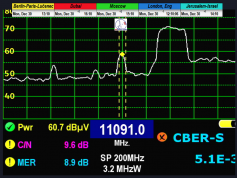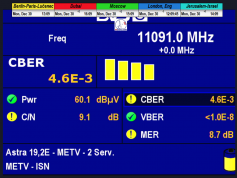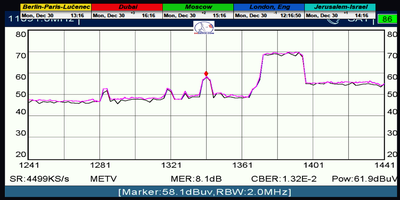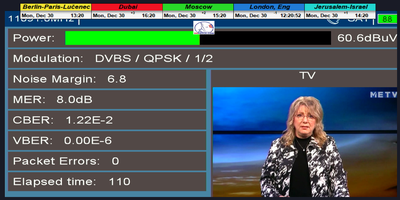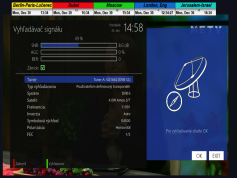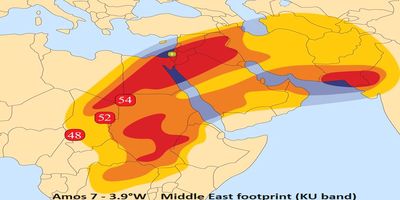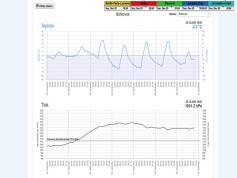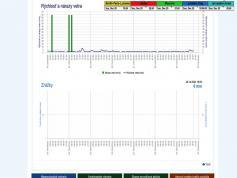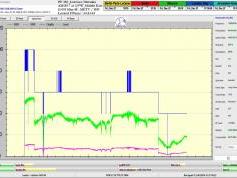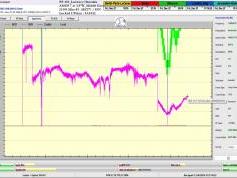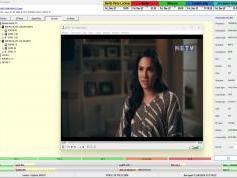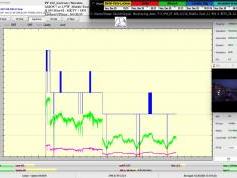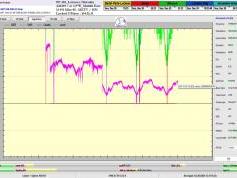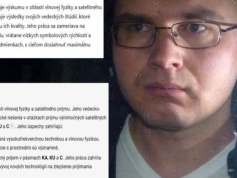Amos 7 at 3.9°W-The Middle East footprint in the geographical region of Central Europe:11 091 MHz_H_METV-Middle East TV+It's Supernatural! Network : Scientific and research activities verified through signal monitoring in the field of wave physics
Amos 7 at 3,9°W_Middle East footprint_H : 11 091 MHz - METV/ISN
PF 450 cm:Visualized proving verified in the minimum monitoring unit t=72 hours
Note : In this scientific and research center, the functionality of a technological process and invention called Synchronous Nanocorrections,
authored by Roman Dávid from Lučenec, is systematically proven, and it is also the only place where you can encounter the benefits of this technology.
In diesem wissenschaftlichen und Forschungszentrum wird systematisch die Funktionalität des technologischen Verfahrens und der Erfindung
mit dem Namen "Synchrone Nanokorrekturen" vom Autor Roman Dávid aus Lučenec nachgewiesen. Es ist gleichzeitig der einzige Ort,
an dem Sie dieser Technologie persönlich begegnen können.
Upozornenie : V tomto vedecko-výskumnom centre sa systematicky dokazuje funkcia technologického postupu a vynálezu s názvom
"Synchrónne nanokorekcie", od jej autora Romana Dávida z Lučenca a je to zároveň jediné miesto kde sa s výhodami tejto technológie môžete stretnúť
( Last update date: 8.1.2025 )
v zemepisnej oblasti stredná Európa.
status for the originally starting broadcast frequency of Middle East TV/ISN at f=11,091 MHz_H regarding the possibility of satellite reception from the Middle East beam
of the Amos 7 satellite at 3.9°W in the geographical region of Central Europe.
►DE_Heute kann ich auf Grundlage eines Signalmonitorings über eine Dauer von t=100+ Stunden zweifelsfrei die Gründe darlegen, warum ich den langfristigen
Referenzstatus für die ursprünglich als Startfrequenz genutzte Broadcast-Frequenz von Middle East TV/ISN bei f=11,091 MHz_H in Bezug auf die Möglichkeit des
Satellitenempfangs aus der Middle-East-Beam der Amos-7-Satellitenposition bei 3,9°W in der geografischen Region Mitteleuropa widerrufen habe.
►►Amos 7 at 3.9°W-Midle East : Justification of Proving/Zdôvodnenie dokazovania
SK_Metodický postup meraní,ktorý verifikuje nespochybnitelné výsledky odvodené od minimálnej jednotky monitoringu t=72 hodín
DE_Methodischer Messablauf, der unbestreitbare Ergebnisse aus der minimalen Überwachungseinheit bei t=72 Stunden ableitet
und verifiziert.
satelitného príjmu v danej zemepisnej oblasti.Nesprávny,alebo tiež antimetodický a zavádzajúci postup odvodený len od publikovania
samotných analýz frekvenčného spektra so zamknutými nosnými prenosu vedie výlučne len ku chybným výsledkom,úsudkom a nenaplneným
očakávaniam.Antimetodické a zavádzajúce postupy sa dominantne a už desiatky rokov uplatňujú v amatérskej kategorizácii satelitného príjmu
v zónach "Mimo stopy" označovaného skratkou SAT DX.
the reality of satellite reception in a specific geographical area. Incorrect or anti-methodical approaches, derived solely from the publication
of frequency spectrum analyses with locked carrier frequencies, exclusively lead to erroneous results, judgments, and unfulfilled expectations.
Anti-methodical and misleading procedures have been predominantly applied for decades in the categorization of amateur satellite reception,
denoted by the acronym SAT DX.
die die Realität des Satellitenempfangs in einer bestimmten geografischen Region zeigen. Falsche oder antimethodische Ansätze,
die allein aus der Veröffentlichung von Analysen des Frequenzspektrums mit gesperrten Trägerfrequenzen abgeleitet sind,
führen ausschließlich zu fehlerhaften Ergebnissen, Bewertungen und unerfüllten Erwartungen. Antimethodische und irreführende Verfahren
werden seit Jahrzehnten überwiegend in der Kategorisierung des Amateur-Satellitenempfangs angewendet und durch das Kürzel SAT DX gekennzeichnet.
►►Amos 7 at 3.9°W-Middle East : The installed system applied in verification
►Beim kontinuierlichen Signalmonitoring wurde ein symmetrischer Prodelin-Reflektor mit einem Durchmesser von 450 cm und die
technologische Erfindung des Autors mit dem Titel „Synchrone Nanokorrekturen“ eingesetzt.
►Pri výkone kontinuálneho signálneho monitoringu bol aplikovaný symetrický reflektor Prodelin s priemerom 450 cm a autorov technologický
vynález s názvom "Synchrónne nanokorekcie"
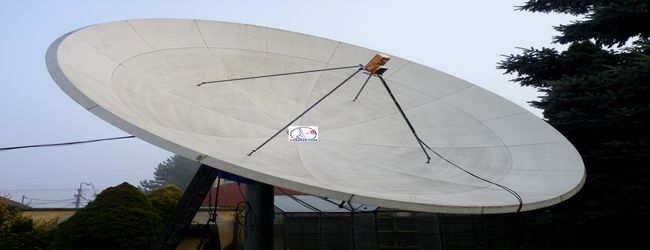
►Signálny reťazec je tvorený / The signal chain consists of the following components : Prodelin 450cm
3x LNB SMW : LNB SMW_Q-PLL type R, LOF stabilita +/- 25 kHz _ LNB SMW_Q-PLL type O,LOF stabilita +/- 10 kHz _ SMW PLL LNB 9.75 GHz,LOF stabilita +/- 10 kHz
+Svojpomocne vyrobený kartónový kryt z nealko nápoja od švajčiarskej firmy SIG-Combibloc,na ktorý som nalepil nepremokavú fóliu odolnú proti poveternostným
podmienkam
►Reflector PF Prodelin 450 cm > Primary feed horn positioned in a manual SKEW rotation mechanism > OMT orthomode transducer, model ESA-1212-X/1 >
SMW_Q-PLL type R LNB with LOF stability +/- 25 kHz, SMW_Q-PLL type O LNB with LOF stability +/- 10 kHz, and SMW PLL LNB 9.75 GHz with LOF stability +/- 10 kHz
+self-made cardboard cover from a non-alcoholic beverage package by the Swiss company SIG-Combibloc, onto which I applied a waterproof, weather-resistant film.
>SMW Q-PLL Typ R LNB mit LOF-Stabilität von +/- 25 kHz, SMW_Q-PLL Typ O LNB mit LOF-Stabilität von +/- 10 kHz, und SMW PLL LNB 9,75 GHz mit LOF-Stabilität von +/- 10 kHz.
►►Amos 7 at 3.9°W-11 091 MHz-H_Middle East Tv/ISN : Analysis of signal monitoring over a duration of t=100+ hours
v roku 2023/2024
after the frequency reallocation of carriers in 2023/2024.
der Träger im Jahr 2023/2024 widerrufen musste.
►SK Úsek 0>1 : samotná príprava na signálny monitoring
vo frekvenčnom spektre,ktorý spôsoboval stav cyklických výpadkov v Locku nosnej a to pri akejkoľvek výške signálnej rezervy,typicky oscilujúcej od 1 do 3+ dB.
Polopate povedané nech bola výška okamžitej signálnej kvality akákoľvek vysoká (typicky v doobedňajších hodinách od 1,8 do 5+ dB) v obraze
bola neustále prítomná pixelácia a dochádzalo k cyklickým výpadkom v Locku nosnej čo prakticky znamenalo že s výkonom signálneho monitoringu
som nemohol ani len začať.
Po niekoľkých hodinách výskumov som musel pochopiť a zároveň akceptovať že táto chyba spojená s permanentným rastom okamžitej chybovosti ChBER ja na
mojej strane a nejako nesúvisí s ultra nízkou hladinou v intenzite výkonu vlnenia v H polarizácii na f=11 091 MHz v diagrame Middle East družice
Amos 7 na 3,9°W.
K tomuto presvedčeniu som dospel po hĺbkovej analýze,pretože som nechápal ako je možné že stabilný príjem nebol možný ani pri výške signálnej rezervy okolo 3 dB.
Potom čo som v doobedňajších hodinách dňa 25.12.2024 našiel príčinu,zdroj rušenia a hlavne harmonickú zložku signálu,ktorá sa superponovala vo
frekvenčnom spektre analyzovanej nosnej sa okamžite hladina signálneho poľa vo vlnovode stabilizovala a od tohto momentu sa datuje že aj pri ultra
nízkej výške kvality okolo SNR=1,8-2,5 dB dosahujem plne stabilný príjem bez akýchkoľvek výpadkov v Locku (alebo Pixelácie),čo je v kontexte použitého
programu EBSPro už záporná výška signálnej rezervy z dôvodu aplikovanej konfigurácie modulačných parametrov DVB-S/QPSK/FEC=1/2 pri výške minimálneho
odstupu C/N pre Lock vo výške len CN=2,7 dB.Keby sa mi nepodarilo identifikovať a odstrániť príčiny spojené s rušením analyzovanej nosnej vo frekvenčnom
spektre,ktoré boli jednoznačne na mojej strane a nijako nesúvisely so signálnymi podmienkami spojenými s príjmom v zóne "Out of footprit",alebo Mimo stopy,
potom by som nemal dnes čo publikovať a chybne by som kategorizoval tento príjem označením "Čakanie na náhodu,alebo špičku výkonu-Sat DX".
Do desiatich minút potom ako som vymenil chybný komponent v signálnom reťazci a hladina signálneho poľa sa stabilizovala a prestala cyklicky a vo vysokej amplitúde
oscilovať a potom čo som na anténnom systéme,pomocou digitálneho uhlomera nastavil hodnotu EL=29,69°, signálna kvalita skokovo dosiahla priam giganticky
vysokej úrovne okolo SNR=10-11,2 dB,ktorú som doteraz nikdy nezaznamenal,čo je reálna výška rezervy okolo 7-8 dB,ktorá umožňuje nestabilnú formu
Locku už na minimálnych priemeroch reflektorov od d=180 do 220 cm.
►Dokazovanie vo video ukážke že aj pri minimálnej výške kvality v rozsahu od SNR=1,9-2,5 dB je príjem plne stabilný,bez akejkolvek pixelácie v obraze
alebo výpadkov v Locku vďaka stabilnej hladine signálneho poľa potom čo som odstránil rušenie vo frekvenčnom spektre
-špička kvality oscilovala od 10 do 11+ dB dňa 25.12.2024- -plná stabilita príjmu bez jedinej pixlácie aj pri minimálnej úrovni kvality od 1,9 do 2,5 dB-


ktorý sa stal takým typickým nie len pri príjme z družice Amos 7 v strednej Európe a ktorý primárne nesúvisí s výkonom môjho vynálezu s názvom
"Synchrónne nanokorekcie".Sekundárne,samozrejme výška týchto vysokých výkonových a kvalitatívnych skokových rastov súvisí so základnými
fyzikálnymi parametrami môjho anténneho systému ako je napríklad -3 dB beamwidth_(theta) :.......................
dochádzať k prudkým a skokovým zmenám v intezite jej výkonu,čo úplne vylučuje z hry nosnú f=11 091 MHz_H ale aj všetky nosné frekvencie
zo spektra Horizontálnych vektorov vlnení od 11 035 do 11 091 Mhz_H,pretože ako nasledovne dokážem,práve na tejto frekvencii dochádza k fyzikálnym
javom vysokého a skokového rastu výkonu a kvality na ktoré čakajú všetci lovci a čakatelia na signálne anomálie z kategórie SAT DX,aby mohli
následne všetkých fanúšikov zavádzať a manipulovať vo význame:Kedže sme tí "najväčší experti",nám postačuje priemer reflektora len 180 do 240 cm
na to aby sme dosiahli "sat. príjem" METV z Amosu 7. Ja by som si nič podobné nikdy nedovolil tvrdiť.Pochopitelne tieto priam detinské klamstvá z materskej
skôlky môže odhaliť a rozdiel medzi stabilným príjmom a prebiehajúcou anomáliou dokázať jedine Signálny monitoring s dostatočnou jednotkou
dĺžky monitoringu,čo je dôvodom prečo som si stanovil konkrétne pre tento prípad družice Amos 7 dostatočne dlhú jednotku monitoringu
t=100+ hodín,aby každý pochopil a videl že na družici Amos 7 sa tieto anomálie,alebo neštandardne vysoké výkonové rasty a poklesy necyklicky
opakujú.Konkrétne u mňa sa vykytli 2x na 5 dní (konkrétne 25 a 30.12.2024),čiže ak si dostotočne dlho počkáte,potom aj Vy sa môžete stretnúť s náhodnou
a nestabilnou formou Locku METV na f=11 091 MHz už s minimálnym priemerom reflektora od 180 do 300 cm pre formu Sat DX v oblasti strednej Európy.
Len potom čo sa Vám to náhodou podarí prosím nepíšte hned články a nezavádzajte verejnosť,ale napíšte pravdu že Váš "príjem" je možný len z dôvodu
dočasného výskytu výkonovej anomálie,tak typickej pri príjme z družice Amos 7_Middle East beam. ►Teraz dokážem že moje tvrdenia sa zakladajú na nespochybnitelných dôkazoch.V poradí druhý výskyt výkonovej anomálie za 5 dní od 25 do 30.12.2024.
Takmer skokový rast intenzity výkonu až o 40 jednotiek dňa 30.12.2024,(anomália) a následný rast kvality z 0 na SNR=8 dB + online video ukážka,ktorá
vylučuje akékolvek pochybnosti či sa to o čom píšem aj reálne deje v praxi
zónach príjmu má samozrejme nulovú vedeckú hodnotu lebo už nasledujúcu sekundu,minútu,hodinu... po lock-u môže kvalita poklesnúť na nulu
a publikovanie týchto pseudo-analýz je vo svojej podstate zbytočné a klamlivé.
celú verejnosť by som len zavádzal a klamal pretože tento signálny stav trval len okolo 2,5 hodiny a potom kvalita skokovo poklesla z 11 na SNR=6 dB čo je pokles
až o 26 výkonových jednotiek,ale stabilita príjmu ostala aj nadalej zachovaná (56>30_Pretože ako je všeobecne známe a z hľadiska Signálneho monitoringu
v programe EBSpro je tomu presne naopak,pretože úroveň výkonu 0 dBm (decibel-milliwatt) je výrazne vyššia ako úroveň výkonu -25 dBm a rozdiel je značný,
pretože výkon klesá exponenciálne pri znížení dBm a 0 dBm zodpovedá referenčnej hodnote výkonu 1 mW (milliwatt).
a nedajú sa akýmkoľvek spôsobom spochybniť a pokračujem v citácii :Prezentácia sekundových Lockov zo spektra má samozrejme nulovú vedeckú hodnotu
lebo už nasledujúcu sekundu,minútu,hodinu... po lock-u môže kvalita poklesnúť na nulu a publikovanie týchto pseudo-analýz je vo svojej podstate zbytočné
až klamlivé.Na základe dokázatelne pravdivých mojich tvrdení,verím že teraz už chápete prečo nikto príčetný nemôže argumentovať Lockom
zo spektra vo význame že "niečo som už dosiahol" v satelitnom príjme,pretože ten Lock a kvalita vyjdruje len stav v danej sekunde Locku
a už nasledujúcu sekundu môže byť všetko naopak a Lock už ani nemusí byť prítomný.Moje tvrdenia samozrejem platia výlučne pre zóny príjmu
"Out Of footprint" nie pre zóny "Within the satellite coverage area" pretože v nich je intenzita výkonu garantovaná operátorom a ak sa nevyskytne porucha
na vysielacej strane,alebo udalosť spojená s nepriaznivými poveternostnými dejmi potom stav v kvalite príjmu ostáva trvalo na porovnatelnej úrovi
a v tomto prípade verejná prezentácia sekundových Lockov zo spektra nezávadza nikoho,ale pravdivo odzrkadľuje realitu príjmu v danej zemepisnej oblasti.
V mojej bohatej praxi som sa ovšem stretol aj s prípadom ked satelitný operátor z Jordánska vysielal na družicu Al Yah 1 at 52.5°E nestabilný a pixelujúci signál,
ktorý nedokázal stabilne príjimať z družice Measat a takto znehodnotený a bitovo poškodený signál opätovne redistribuoval na družicu Al Yah 1 z pôvodne
Measatu do diagramu MENA.Čiže sú aj výnimky že s vysokou kvalitou príjimate signál s nízkou kvalitou,ktorý Vám hodiny počas dňa pixeluje a vypadáva
aj napriek stabilne vysokej úrovni kvality na sat. príjimači.
chybového a pixelujúceho signálu na družicu Al Yah 1 ich očividne a niekolko rokov netrápila aj napriek mojim upozorneniam.
►SK Úsek 1>2 : od cca 11:26 CET do cca 14:40 CET dňa 25.12.2024_cca 3 hodiny a 14 minút
monitoringu pričom kvalita príjmu v jednotke SNR dosahuje dovtedy nedosiahnutelné a zároveň giganticky vysoké špičky viac ako 11 dB,ako dôsledok skokového
rastu,alebo necyklicky sa opakujúcej výkonovej anomálie,tak typickej pre príjem z družice Amos 7 v strednej Európe.Frekvencia výskytu a opakovania podobných
anomálii : v úseku meraní od 25 do 31.12.2024 : 2x . Stabilita príjmu v tomto časovo ohraničenom úseku : 100% !
►SK úsek 3>4 : od cca 14:40 CET 25.12.2024 do cca 08:40 CET dňa 27.12.2024_cca 42 hodín
Na začiatku monitorovaného úseku označeného ako 3>4 došlo k vysokému a skokovéme poklesu výkonu až o 25 jednotiek (vychádzajúc zo súradnicového zobrazenia
softwéru EBSPro v signálnom monitoringu,nie o 25 jednotiek dBm_decibel-milliwatt),alebo k okamžitému prepadu kvality príjmu z okolo SNR=10-11+ dB na
cca SNR=6 dB čo je aj nadalej vysoká rezerva viac ako 3 dB nad šumovým prahom.V úseku od 17:30 do 18:00 CET došlo v dvoch bododch k sekundovým výpadkom
v Locku nosnej v celkovej dĺžke výpadku rádovo jednotky sekúnd,cca 5-10 sec.,pretože modrý priebeh kvality "Q" bol v skutku prerušený nejednalo sa len o pixeláciu
obrazu,ale o skutočný výpadok v kontinuite Locku.Dosiahnutá stabilita príjmu vyjadrená percentuálne v tomto časovo ohraničenom úseku : 99,9934 % !
►SK Úsek 5>6 : od cca 08:40 CET dňa 27.12.2024 do konca monitoringu dňa 29.12.2024 o 19:37 CET
kvalita príjmu osciluje už len v rozsahu od 0 do 4,5 dB.Došlo 3x k väčším výpadkom v dĺžke rádovo minút v rozsahu dní 28-29.12.2024 a jednej sekundovej pixelácii
v okolí šumového prahu dňa 27.12.2024.Po celkovom súčte výpadkov a pixelácii rádovo v minútach na cca 40 minút a (zaokrúhlil som to nahor nie na dol,aby som
nikoho nezavádzal) stabilita príjmu v tomto časovo ohraničenom úseku dosiahla presne : 98.87 %
presne : 99,34452 % v jednotke signálneho monitoringu t=104 hodín a 15 minút,inak povedané z celkovej jednotky 104 hodín a 15 minút som dosiahol
►EN_The monitoring segment 0>1_or the preparation for monitoring itself.
►EN_In order to begin and carry out signal monitoring, I had to identify and eliminate the source of interference in the frequency spectrum, which was causing
periodic lock failures of the carrier signal at any signal reserve level, typically oscillating from 1 to 3+ dB. To put it simply, no matter how high the
current signal quality was (typically in the morning hours from 1.8 to 5+ dB), pixelation was always present in the image, and there were periodic
lock failures of the carrier signal. This meant that I couldn't even begin signal monitoring. After several hours of research, I had to understand and accept
that this error, associated with the permanent increase in instantaneous ChBER errors, was on my side and was not related to the ultra-low level
of wave power intensity in H polarization at f=11,091 MHz in the Middle East region of the Amos 7 satellite at 3.9°W. I reached this conclusion after
a thorough analysis, as I couldn't understand how it was possible that a stable signal could not be achieved even with a signal reserve of around 3 dB.
Then, on the morning of December 25, 2024, after identifying the cause of interference and, most importantly, the harmonic component of the signal
superimposed in the frequency spectrum of the analyzed carrier, the signal field strength in the waveguide immediately stabilized.
From this moment on, even at ultra-low quality levels around SNR=1.8-2.5 dB, I was able to achieve fully stable reception without any lock failures
(or pixelation), which, in the context of the EBSPro program used, is already a negative signal reserve due to the applied DVB-S/QPSK/FEC=1/2
modulation configuration and the minimal C/N lock threshold of only CN=2.7 dB. Had I not been able to identify and eliminate the interference sources
in the frequency spectrum of the analyzed carrier, which were clearly on my side and had nothing to do with the signal conditions associated with reception in the
"Out of Footprint" zone, I would have nothing to publish today and would have incorrectly categorized this reception as "Waiting for Chance or Peak Performance - Sat DX."
Within ten minutes after replacing the faulty component in the signal chain, and the signal field strength stabilized and ceased to oscillate in high amplitude cyclically,
and after setting the antenna system to EL=29.69° using a digital inclinometer, the signal quality jumped to an extraordinarily high level of SNR=10-11.2 dB,
which I had never recorded before. This corresponds to a real reserve height of around 7-8 dB, enabling an unstable lock form even with minimal
reflector diameters from d=180 to 220 cm.
►The demonstration in the video showing that even at a minimal quality level in the range of SNR = 1.9-2.5 dB, the reception remains fully stable,
without any pixelation in the image or lock losses, due to the stable signal field level after the removal of interference in the frequency spectrum.
-The quality peak oscillated between 10 and 11+ dB on 25.12.2024-+ Full reception stability without a single pixelation even at the minimum quality level
ranging from SNR=1.9 to 2.5 dB+ video proof


and reception quality, which has become typical not only for the reception from the Amos 7 satellite in Central Europe but primarily does not relate to the
performance of my invention called "Synchronous Nanocorrections." Secondarily, of course, the magnitude of these high jumps in power and quality is related
to the basic physical parameters of my antenna system, such as the -3 dB beamwidth (theta) :
and sharp changes in its intensity, which completely excludes the carrier f = 11,091 MHz_H from consideration, as well as all carrier frequencies from the spectrum
of Horizontal wave vectors between 11,035 to 11,091 MHz_H. As I will prove next, it is precisely at this frequency that we observe physical phenomena of high
and sudden increases in power and quality, which everyone waiting for signal anomalies from the SAT DX category hopes for, in order to later mislead and manipulate
enthusiasts with the following: "Since we are the 'greatest experts,' a reflector with a diameter of only 180 to 240 cm is sufficient for us to achieve 'sat. reception'
of METV from Amos 7."
monitoring unit, which is why I have specifically set a sufficient length of monitoring for this case of the Amos 7 satellite, t = 100+ hours, So that everyone understands
and sees that on the Amos 7 satellite, these anomalies, or unusually high power increases and decreases, repeat non-cyclically.Specifically, I encountered them
twice over 5 days (on 25th and 30th December 2024). Therefore, if you wait long enough, you may also experience a random and unstable form of METV
Lock on f = 11,091 MHz with a minimum reflector diameter between 180 and 300 cm for Sat DX form in Central Europe.
due to the temporary occurrence of a power anomaly, so typical for reception from the Amos 7 Middle East beam.
►"Now I can prove that my claims are based on undeniable evidence. The second occurrence of a power anomaly within 5 days from December 25th to 30th, 2024.
A near-sudden increase in power intensity by 40 units on December 30th, 2024 (anomaly), followed by a rise in quality from 0 to SNR=8 dB + online video demonstration,
which eliminates any doubts about whether what I am describing is happening in practice."..... PWR anomaly is in progress_30.12.2024+ video proof
"The presentation of second-locks from the frequencyspectrum during highly dynamic and persistent changes in power intensity in these reception zones inherently
possesses zero scientific value because the quality may drop to zero the following second,minute,hour... after the lock,rendering the entire presentation of this
pseudo-analysis essentially pointless and deceptive."
with an SNR = 11.2 dB, I would only be misleading and deceiving the public because this signal state lasted only about 2.5 hours, and then the quality
suddenly dropped from 11 to SNR = 6 dB, a drop of 26 power units, yet the reception stability remained intact (56 > 30). As is generally known and in signal
monitoring software like EBSpro, the performance level of 0 dBm (decibel-milliwatt) is much higher than -25 dBm, and the difference is significant, as performance drops
exponentially when the dBm decreases, with 0 dBm corresponding to the reference power level of 1 mW (milliwatt).
cannot be disputed in any way. I continue with the citation: "The presentation of secondary locks from the spectrum has no scientific value because, in the next second,
minute, or hour after the lock, the quality can drop to zero, and publishing these pseudo-analyses is essentially unnecessary and misleading." Based on the proven truth
of my claims, I believe you now understand why no sensible person can argue that a spectrum lock means "something has been achieved" in sat. reception
because that lock and quality only reflect the state at the moment of the lock, and in the next second, everything can be the opposite, and the lock may not
even be present.
intensity is guaranteed by the operator, and if no failure occurs on the transmission side, or an event related to adverse weather phenomena, the reception quality remains
stable at a comparable level. In this case, the public presentation of secondary locks from the spectrum does not mislead anyone, but truthfully reflects the reception reality
in that geographical area.
diagram. Therefore, there are exceptions when you receive a high-quality signal, but it is of low quality, pixelating and dropping out despite the consistently high signal level
on the satellite receiver.
of the highly error-prone and pixelated signal to the Al Yah 1 satellite did not concern them for several years, despite my warnings.
►EN_The monitoring segment 1>2_od cca 11:26 CET do cca 14:40 CET dňa 25.12.2024_cca 3 hodiny a 14 minút
of the monitoring, during which the reception quality in the SNR unit reaches previously unattainable and extremely high peaks of over 11 dB. This is a consequence
of a sudden increase or a non-cyclically recurring power anomaly, which is typical for reception from the Amos 7 satellite in Central Europe. The frequency of occurrence
and repetition of such anomalies in the measurement period from December 25 to 31, 2024: 2 times. The stability of the reception in this time-limited period: 100%.
►EN_The monitoring segment 3>4_od cca 14:40 CET 25.12.2024 do cca 08:40 CET dňa 27.12.2024_cca 42 hodín
At the beginning of the monitored section labeled 3>4, there was a significant and sudden drop in power by 25 units (based on the coordinate display of the EBSPro
software in the signal monitoring, not 25 dBm decibel-milliwatt units), or an immediate decrease in reception quality from around SNR=10-11+ dB to approximately
SNR=6 dB, which is still a high margin of more than 3 dB above the noise threshold. Between 17:30 and 18:00 CET, there were two brief outages in the carrier lock
lasting a total of several seconds, around 5-10 sec., because the blue quality curve "Q" was indeed interrupted, not just showing pixelation, but a true outage in the
continuity of the lock. The reception stability achieved, expressed as a percentage, in this time-limited period: 99.9934%.
►EN_The monitoring segment 5>6_ od cca 08:40 CET dňa 27.12.2024 do konca monitoringu dňa 29.12.2024 o 19:37 CET
approximately 58 hours, the reception quality oscillates within the range from 0 to 4.5 dB. There were 3 larger outages lasting several minutes between
December 28-29, 2024, and one second-long pixelation around the noise threshold on December 27, 2024. After summing up the outages and pixelations,
totaling around 40 minutes (rounded up, not down to avoid misleading anyone), the reception stability in this time-limited period reached exactly: 98.87%.
a total reception stability expressed as a percentage of exactly: 99.34452% in the signal monitoring unit t=104 hours and 15 minutes. In other words,
out of the total 104 hours and 15 minutes, I achieved full reception stability for METV at f=11,091 MHz_H without a single pixelation or outage for 103 hours
and 34 minutes, which, critically speaking, is an acceptable result.
DE_Der Überwachungs Abschnitt 0>1_oder die Vorbereitung auf die Überwachung selbst.
►DE_Um mit der Signalüberwachung zu beginnen und den Nachweis zu erbringen, musste ich die Quelle der Störung im Frequenzspektrum identifizieren und eliminieren,
die periodische Lock-Ausfälle des Trägersignals bei jeder Signalreservehöhe verursachte, die typischerweise von 1 bis 3+ dB oszillierte. Einfach ausgedrückt, unabhängig
davon, wie hoch die aktuelle Signalqualität war (typischerweise am Vormittag von 1,8 bis 5+ dB), war immer Pixelbildung im Bild vorhanden, und es kam zu periodischen
Lock-Ausfällen des Trägersignals. Das bedeutete, dass ich die Signalüberwachung nicht einmal beginnen konnte. Nach mehreren Stunden der Forschung musste ich verstehen
und akzeptieren, dass dieser Fehler, der mit dem permanenten Anstieg der sofortigen ChBER-Fehler verbunden war, auf meiner Seite lag und nichts mit dem ultraniedrigen
Leistungsniveau der Wellenintensität in H-Polarisation bei f=11.091 MHz im Nahen Osten des Amos 7 Satelliten bei 3,9°W zu tun hatte. Zu dieser Überzeugung kam ich nach
einer gründlichen Analyse, da ich nicht verstehen konnte, wie es möglich war, dass ein stabiler Empfang selbst bei einer Signalreserve von etwa 3 dB nicht erreicht werden
konnte. Dann, am Vormittag des 25. Dezember 2024, nachdem ich die Ursache der Störung und vor allem die harmonische Komponente des Signals identifiziert hatte,
die sich im Frequenzspektrum des analysierten Trägersuperponierte, stabilisierte sich sofort die Signalfeldstärke im Wellenleiter. Ab diesem Moment war es selbst bei
ultraniedrigen Qualitätswerten von SNR=1,8-2,5 dB möglich, einen vollständig stabilen Empfang ohne Lock-Ausfälle (oder Pixelbildung) zu erreichen, was im Kontext
des verwendeten EBSPro-Programms bereits eine negative Signalreserve aufgrund der angewandten DVB-S/QPSK/FEC=1/2-Modulationskonfiguration und des minimalen
C/N-Lock-Schwellenwerts von nur CN=2,7 dB darstellt. Hätte ich die Störquellen im Frequenzspektrum des analysierten Trägers, die eindeutig auf meiner Seite lagen und
nichts mit den Empfangsbedingungen in der Zone "Out of Footprint" zu tun hatten, nicht identifizieren und eliminieren können, hätte ich heute nichts zu veröffentlichen
und würde diesen Empfang fälschlicherweise als "Warten auf Zufall oder Spitzenleistung - Sat DX" kategorisieren. Innerhalb von zehn Minuten, nachdem ich das fehlerhafte
Bauteil in der Signalkette ausgetauscht hatte und sich die Signalfeldstärke stabilisierte und nicht mehr hochamplitudisch oszillierte, und nachdem ich das Antennensystem
mit einem digitalen Neigungsmesser auf EL=29,69° eingestellt hatte, sprang die Signalqualität auf ein außergewöhnlich hohes Niveau von SNR=10-11,2 dB, das ich zuvor
noch nie aufgezeichnet hatte. Dies entspricht einer realen Reservehöhe von etwa 7-8 dB, die eine instabile Lock-Form auch bei minimalen Reflektordurchmessern
von d=180 bis 220 cm ermöglicht.
stabil ist,ohne jegliche Pixelierung im Bild oder Ausfälle im Lock, dank der stabilen Signalpegelhöhe nach der Beseitigung von Störungen im
Frequenzspektrum. Die Qualitätsspitze oszillierte zwischen 10 und 11+ dB am 25.12.2024 Volle Empfangsstabilität ohne eine einzige Pixelierung selbst bei der minimalen
Qualitätsstufe von SNR=1,9 bis 2,5 dB


Jetzt kann ich das wiederholte Auftreten nachweisen und die Ursachen im Zusammenhang mit dem physikalischen Phänomen in Form eines Sprungs in der
Leistungsintensität und der Empfangsqualität benennen, der nicht nur bei der Empfang von Amos 7 in Mitteleuropa typisch wurde und primär nichts mit der Leistung
meiner Erfindung namens „Synchronisierte Nanokorrekturen“ zu tun hat. Sekundär hängt natürlich die Höhe dieser plötzlichen Sprünge in der Leistung und Qualität mit
den grundlegenden physikalischen Parametern meines Antennensystems zusammen, wie zum Beispiel der -3 dB Strahlbreite (Theta) :
Ein Attribut für die Zuweisung des Referenzstatus für eine gegebene Frequenz „f0“ (aktuell f0 = 10,890 MHz) ist die Bedingung der ausgewogenen Intensität der EIRP
(Effektive Isotrope Strahlleistung) über Zeit, Tag/Nacht usw. Anders ausgedrückt, um eine gegebene Frequenz „f“ als „f0“ zu klassifizieren, dürfen keine plötzlichen
und scharfen Änderungen in ihrer Intensität auftreten, was die Trägerfrequenz f = 11,091 MHz_H sowie alle Trägerfrequenzen im Bereich der horizontalen
Wellenvektoren zwischen 11,035 und 11,091 MHz_H vollständig ausschließt. Wie ich im Folgenden nachweisen werde, treten genau bei dieser Frequenz physikalische
Phänomene mit hohen und plötzlichen Anstiegen in der Leistung und Qualität auf, auf die alle, die auf Signalstörungen aus der SAT DX-Kategorie warten, hoffen,
um später die Öffentlichkeit zu täuschen und mit dem folgenden zu manipulieren: „Da wir die ‚größten Experten‘ sind, reicht uns ein Reflektor mit einem Durchmesser
von nur 180 bis 240 cm, um den ‚sat. Empfang‘ von METV aus Amos 7 zu erreichen.“
Ich würde nie eine solche Behauptung aufstellen. Natürlich können diese kindischen falschen Behauptungen nur durch Signalüberwachung mit einer ausreichend langen
Monitoring-Einheit aufgedeckt werden, weshalb ich speziell für diesen Fall des Amos 7 Satelliten eine ausreichend lange Monitoring-Einheit von t = 100+ Stunden
festgelegt habe, damit jeder versteht und sieht, dass diese Anomalien oder ungewöhnlich hohen Sprünge in der Leistung und Qualität zyklisch wiederkehren.
Konkret habe ich sie zweimal über 5 Tage (am 25. und 30. Dezember 2024) festgestellt. Daher, wenn du lange genug wartest, kannst du auch auf eine zufällige
und instabile Form des METV-Locks auf f = 11,091 MHz stoßen, mit einem minimalen Reflektordurchmesser zwischen 180 und 300 cm für Sat DX in Mitteleuropa.
►"Jetzt kann ich beweisen, dass meine Behauptungen auf unbestreitbaren Beweisen basieren. Das zweite Auftreten einer Leistungsanomalie innerhalb von 5 Tagen
vom 25. bis 30. Dezember 2024. Ein nahezu plötzlicher Anstieg der Leistung um 40 Einheiten am 30. Dezember 2024 (Anomalie), gefolgt von einem Anstieg
der Qualität von 0 auf SNR=8 dB + Online-Video-Demonstration, das alle Zweifel ausräumt, ob das, worüber ich schreibe, auch tatsächlich in der Praxis geschieht."
PWR Anomalie ist im Gange + Videobeweis...
Sobald dir das zufällig gelingt, schreibe bitte nicht sofort Artikel und täusche die Öffentlichkeit, sondern schreibe die Wahrheit: Dein „Empfang“ ist nur aufgrund
des vorübergehenden Auftretens einer Leistungsanomalie möglich, die so typisch für den Empfang vom Amos 7 Middle East Beam ist.
Jetzt verstehst du sicherlich, warum ich im Zusammenhang mit meiner methodischen Vorgehensweise den Satz verwendet habe: „Die Präsentation
von sekundären Locks aus dem Frequenzspektrum bei hochdynamischen bis permanenten Änderungen in den Leistungsintensitäten in diesen
Empfangszonen hat natürlich keinen wissenschaftlichen Wert, da die Qualität bereits in der nächsten Sekunde, Minute oder Stunde nach dem Lock
auf null fallen kann und die Veröffentlichung dieser Pseudo-Analysen grundsätzlich unnötig und irreführend ist.“
Denn wie du siehst und durch Signalüberwachung nachgewiesen werden kann, wenn ich einen Frequenzspektrums-Scan mit einem Lock auf den
Träger bei f = 11,091 MHz mit einem SNR = 11,2 dB durchführen würde, würde ich nur die Öffentlichkeit in die Irre führen und täuschen,
da dieser Signalzustand nur etwa 2,5 Stunden dauerte und dann die Qualität plötzlich von 11 auf SNR = 6 dB fiel, ein Rückgang um 26 Leistungseinheiten,
während die Empfangsstabilität weiterhin intakt blieb (56 > 30). Wie allgemein bekannt und in der Signalüberwachungssoftware wie EBSpro ist der Leistungspegel von
0 dBm (Dezibel-Milliwatt) deutlich höher als -25 dBm, und der Unterschied ist erheblich, da die Leistung exponentiell sinkt, wenn dBm sinken, wobei 0 dBm dem
Referenzleistungswert von 1 mW (Milliwatt) entspricht.
Daher ist hier der Beweis, dass meine Behauptungen über das Auftreten von hochdynamischen bis permanenten Änderungen der Leistungsintensitäten in diesen
Empfangszonen wahr sind und auf keine Weise angezweifelt werden können. Ich fahre mit der Zitation fort: „Die Präsentation von sekundären Locks aus dem
Spektrum hat natürlich keinen wissenschaftlichen Wert, da die Qualität bereits in der nächsten Sekunde, Minute oder Stunde nach dem Lock auf null fallen kann
und die Veröffentlichung dieser Pseudo-Analysen grundsätzlich unnötig und irreführend ist.“ Basierend auf den nachweislich wahren Behauptungen glaube ich,
dass du nun verstehst, warum niemand vernünftigerweise argumentieren kann, dass ein Lock aus dem Spektrum bedeutet, dass im Satellitenempfang
„etwas erreicht wurde“, weil dieser Lock und die Qualität nur den Zustand zum Zeitpunkt des Locks widerspiegeln, und in der nächsten Sekunde
kann alles genau das Gegenteil sein und der Lock ist möglicherweise nicht mehr vorhanden.
Meine Behauptungen gelten natürlich ausschließlich für Empfangszonen „Out Of Footprint“, nicht für Zonen „Within the Satellite Coverage Area“, da in diesen
die Leistungsintensität vom Betreiber garantiert wird und, wenn keine Störungen auf der Übertragungsseite auftreten oder Ereignisse mit ungünstigen
Wetterphänomenen, bleibt der Empfang in dieser Qualität stabil und vergleichbar. In diesem Fall führt die öffentliche Präsentation von sekundären Locks aus
dem Spektrum niemanden in die Irre, sondern spiegelt wahrheitsgemäß die Empfangsrealität in diesem geographischen Bereich wider.
In meiner umfangreichen Praxis bin ich jedoch auch auf einen Fall gestoßen, als ein Satellitenbetreiber aus Jordanien ein instabilen und pixelierten Signal auf
den Al Yah 1 Satelliten bei 52,5°E gesendet hat, das nicht stabil vom Measat Satelliten empfangen werden konnte und dieses fehlerhafte Signal dann wieder
auf den Al Yah 1 Satelliten aus dem Measat Satelliten-Feed in das MENA-Diagramm übertragen wurde. Es gibt also auch Ausnahmen, bei denen du ein
hochqualitatives Signal empfängst, das jedoch niedriger Qualität ist, pixeliert und ausfällt, trotz des stabil hohen Signalpegels am Satellitenempfänger.
Erklärung: Der Betreiber verfügte nicht über einen Reflektor mit einem ausreichend großen Durchmesser für einen stabilen Empfang vom Measat-Satelliten,
und die anschließende Signalumverteilung des stark fehleranfälligen und verpixelten Signals auf den Al Yah 1-Satelliten bereitete ihnen trotz meiner Warnungen
mehrere Jahre lang keine Sorgen.
►DE_Der Überwachungs Abschnitt 1>2_od cca 11:26 CET do cca 14:40 CET dňa 25.12.2024
Der grüne Verlauf der Leistungspegel, der blaue Verlauf der Qualitätskurve Q und der rosa Verlauf des Signal-Rausch-Verhältnisses bleiben mehr als 3 Stunden
nach Beginn der Überwachung auf ihren Maximalwerten, wobei die Empfangsqualität in der SNR-Einheit Werte erreicht, die zuvor unerreichbar waren und
gleichzeitig gigantisch hohe Spitzen von mehr als 11 dB aufweisen. Dies ist eine Folge des sprunghaften Anstiegs oder einer nicht zyklischen Leistungsanomalie,
die typisch für den Empfang des Satelliten Amos 7 in Mitteleuropa ist. Die Häufigkeit des Auftretens und der Wiederholung ähnlicher Anomalien im Messzeitraum
vom 25. bis 31.12.2024: 2x. Die Empfangsstabilität in diesem zeitlich begrenzten Abschnitt: 100%!
►DE_Der Überwachungs Abschnitt 3>4_od cca 14:40 CET 25.12.2024 do cca 08:40 CET dňa 27.12.2024
Zu Beginn des überwachten Abschnitts, der als 3>4 bezeichnet wird, kam es zu einem hohen und sprunghaften Leistungsabfall von bis zu 25 Einheiten
(basierend auf der Koordinatendarstellung der Software EBSPro im Signalmonitoring, nicht 25 Einheiten dBm_dezibel-Milliwatt) oder zu einem sofortigen Abfall
der Empfangsqualität von etwa SNR=10-11+ dB auf ca. SNR=6 dB, was immer noch eine hohe Reserve von mehr als 3 dB über dem Rauschpegel bedeutet.
Im Zeitraum von 17:30 bis 18:00 CET kam es an zwei Punkten zu Sekunden-Ausfällen im Lock des Trägers, mit einer Gesamtausfallzeit von wenigen Sekunden,
ca. 5-10 Sek., da der blaue Verlauf der Qualitätskurve "Q" tatsächlich unterbrochen war. Es handelte sich nicht nur um eine Pixelbildung im Bild, sondern um einen
echten Ausfall der Lock-Kontinuität. Die erreichte Empfangsstabilität, ausgedrückt in Prozent, in diesem zeitlich begrenzten Abschnitt: 99,9934%!
►DE_Der Überwachungs Abschnitt 5>6_od cca 08:40 CET dňa 27.12.2024 do konca monitoringu dňa 29.12.2024 o 19:37 CET
von etwa SNR=2 dB. Während der nächsten ca. 58 Stunden oszilliert die Empfangsqualität nur noch im Bereich von 0 bis 4,5 dB. Es gab 3 größere Ausfälle von
jeweils mehreren Minuten im Zeitraum vom 28. bis 29.12.2024 und einen sekundengenauen Pixelfehler in der Nähe des Rauschpegels am 27.12.2024.
Nach der Gesamtzahl der Ausfälle und Pixelfehler von etwa 40 Minuten (ich habe es nach oben gerundet, nicht nach unten, um niemanden in die Irre zu führen)
erreichte die Empfangsstabilität in diesem zeitlich begrenzten Abschnitt exakt: 98,87%.
ausgedrückt in Prozent, von genau: 99,34452% im Signal-Monitoring-Modus t=104 Stunden und 15 Minuten. Anders gesagt, aus der gesamten Zeit von 104 Stunden
und 15 Minuten erreichte ich eine vollständige Empfangsstabilität von METV auf f=11 091 MHz_H ohne jegliche Pixelfehler und Ausfälle in einer Dauer von
103 Stunden und 34 Minuten, was, um ehrlich zu sein, ein akzeptables Ergebnis darstellt.
►►Amos 3 at 4.0°W-Middle East : Beacon frequency / TT&C
Amos 7 : TT&C FREQUENCY > f=11 450.115 MHz_V
Amos 7 : Beacon frequency > 11 450,115 MHz_H
►►Amos 7 at 3.9°W-Middle East: Continuous signal monitoring / Nepretržitý signálny monitoring
> 2, Monitoring of the frequency f=11 091 MHz_H Middle East TV/ISN <
<METV -online scan : 30.12.2024 o 13:22 ráno CET_Lučenec/Slovakia >
,inak povedané dosiahol som plnú stabilu príjmu Middle East TV bez jedinej pixelácia a výpadkov v dĺžke 103 hodín a 34 minút čo je sebakriticky
povedané prijatelný výsledok.
In other words, I achieved full reception stability for Middle East TV without a single pixelation or dropout for a duration of 103 hours and 34 minutes, which,
critically speaking, is an acceptable result.
►DE_Klassifizierung der erzielten Überwachungsergebnisse_f=11 091_H:
In der Einheit der Nachweisführung und Signalüberwachung t=104 Stunden und 15 Minuten habe ich eine Gesamtempfangsstabilität von 99,34452 % erreicht.
Anders gesagt, ich habe volle Empfangsstabilität für Middle East TV ohne jegliche Pixelation oder Ausfälle über einen Zeitraum von 103 Stunden und 34 Minuten
erreicht, was, selbstkritisch gesagt, ein akzeptables Ergebnis ist.
> Typical and daily peak of quality under significantly non-degrading weather conditions on the signal path <
>Typische und tägliche Spitzenqualität unter signifikant nicht degradierenden Wetterbedingungen auf dem Signalweg.<
TBS 5925+EBSpro/CrazyScan : SNR=11,2 dB (Margin: 8,5 dB)
Octagon SF 4008 : SNR=8,0 dB (Margin:5+ dB)
Metek HD : MER=7,0-8,0 (Margin : 6-7 dB)
TELEVES H60 : MER=8,5-8,9 dB/CBER=4.6E-3
►Analýza spektra,kvality a meranie C/N,Pwr... s Televes H60 : 11 091MHz_H - METV/ISN
►Analýza spektra a kvality na f=11 091 MHz_H v jednotke MER dokázavá vo video ukážke na výstupe z kalibrovaného analyzátora METEK HD :
f=11 091 MHz_H : SNR=7,5-8,0 dB (normal peak quality_E2/Open ATV 7.1)
PROVING > Amos 7 at 3,9°W _f=11 091 MHz_H : METV/ISN
Nepretržitý monitoring signálnych parametrov v jednotke t=104 hodín
Continuous monitoring of signal parameters in unit t=104 hours
►Deň záznamu monitoringu : od 25.12.2024 do 29.12.2024
Amos 7 at 3.9°W-footprint : Middle East
Place of sat.reception in Central Europe _ Geografischer Punkt des Satellitenempfangs in Mitteleuropa
Lučenec/Slovakia : 48°19′53″ s. š., 19°40′15″ v. d.
the geographical point of satellite reception is not located on the footprint map
der geografische Punkt des Satellitenempfangs ist nicht auf der Karte verzeichnet
source : Spacecom – Global Communication Service Provider
►Stav atmosféry : na základe meteogramov zo zdrojov shmu.sk môžem potvrdiť že počas výkonu signálneho monitoringu prevládalo
v Lučenci jasno/polojasno bez snehových,alebo dažďových prehánok
TBS 5927+EBSpro >>> SNR peak=11,2 dB
od 25.12.2024 do 29.12.2024
►KOMPLEXNÝ POHĽAD zahrňujúci kvalitu Q v jednotke-% , úroveň výkonu v jednotke dBm , kvalitu SNR v bezrozmernej jednotke dB , chybovosť BER ...
►DETAILNÝ POHĽAD zameraný na kvalitu príjmu a okamžité zmeny odvodené od jednotky merania SNR v trvaní 104 hodín

►Detailná analýza vývoja zmien kvality SNR s časovým kódom počas celého monitorovaného úseku 104 hodín v online video ukážke,
ktorá vylučuje pochybnosti všetkého druhu o reálnosti dosiahnutých úrovní kvality,poprípade akékoľvek dodatočné manipulácie
výpadok alebo pixeláciu obrazu
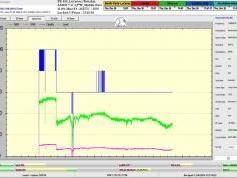
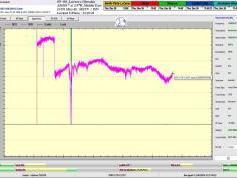
 .....
.....
-okamžitá kvalita osciluje okolo: SNR=6,3 dB -
►+ 104 hodín_Priebežný stav v signálnom monitoringu dňa 29.12.2024 a online video ukážky
-okamžitá kvalita osciluje okolo: SNR=3,5 dB -
►►Amos 7 at 3.9°W-Middle East : copyright : Research project
that come exclusively from scientific research conducted by Roman Dávid - the author and the owner of www.dxsatcs.com. All the information found on
www.dxsatcs.com are protected by copyright as a part of intangible property and are protected by EU law and Slovak national legislation. Usage, copying
and distribution of any information or its parts without author's permission is strictly prohibited.
činnosti autora dxsatcs.com Roman Dávida z oblasti vlnovej fyziky a VF techniky a spadajú do jeho duševného vlastníctva,ktoré je chránené zákonmi
Európskej únie a Slovenskej republiky .Ich celkové alebo čiastočné kopírovanie, imitovanie alebo distribúcia bez súhlasu autora je výslovne zakázaná
z dôvodu výhradného vlastníctva autorom .

